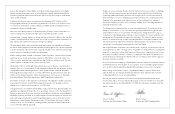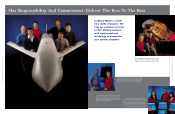Lockheed Martin 2001 Annual Report Download - page 14
Download and view the complete annual report
Please find page 14 of the 2001 Lockheed Martin annual report below. You can navigate through the pages in the report by either clicking on the pages listed below, or by using the keyword search tool below to find specific information within the annual report.
Lockheed Martin Annual Report >>> 21
Lockheed Martin Corporation
December 31, 2001
MANAGEMENT’S DISCUSSION AND ANALYSIS OF FINANCIAL CONDITION AND RESULTS OF OPERATIONS
Lockheed Martin Corporation (Lockheed Martin or the
Corporation) is engaged in the conception, research, design,
development, manufacture, integration and operation of
advanced technology systems, products and services. The
Corporation serves customers in both domestic and interna-
tional defense and commercial markets, with its principal
customers being agencies of the U.S. Government. The fol-
lowing discussion should be read in conjunction with the
audited consolidated financial statements included herein.
Industry Considerations
In recent years, domestic and worldwide political and
economic developments have significantly affected the mar-
kets for defense and advanced technology systems, products
and services. Two events in 2001 had a dramatic impact
on the domestic and international political and economic
landscape. They impacted Lockheed Martin and the defense
industry generally. First, the events of September 11 created
uncertainty and exposed defense vulnerabilities in security
and the overall defense of our homeland. And second,
the conclusions of the Quadrennial Defense Review
(QDR) reflect a transformation to a policy of developing
specific capabilities for overall national defense versus
a policy designed for defeating a specific enemy threat.
Transforming the nation’s defense posture to a capabilities-
based approach involves creating the ability for a more
flexible response with greater force mobility, stronger space
capabilities, missile defense, improved information systems
security and an increased emphasis on homeland defense.
The President’s proposed budget for the U.S. Department
of Defense (DoD) for fiscal year 2003 and beyond reflects
the above-mentioned transformation of national defense pol-
icy and responds to increased needs for homeland security
and defeating terrorism. Budget increases are projected for
operational readiness and personnel needs, as well as for
both the procurement and the research and development
accounts. While there is no assurance that the proposed
increased DoD budget levels will be approved by Congress,
after over a decade of downward trends, the current defense
budget outlook is one of growth. The Corporation’s experi-
ence and capabilities are well aligned with U.S. defense
priorities. Uncertainties remain, however, relative to the
level of growth and the amount of the budget that will be
allocated to the investment accounts (i.e., procurement,
research and development). The following graph depicts
past expenditures and future increases in the defense budget
proposed by the President.
Department of Defense Budget
(In billions)
$0
$200
$300
$400
$500
$100 Operations & Maintenance and Military Personnel
Proposed Budget
Investment
Other
FY
’92 FY
’93 FY
’94 FY
’95 FY
’96 FY
’97 FY
’98 FY
’99 FY
’00 FY
’01 FY
’02 FY
’03 FY
’04 FY
’05 FY
’06 FY
’07
























